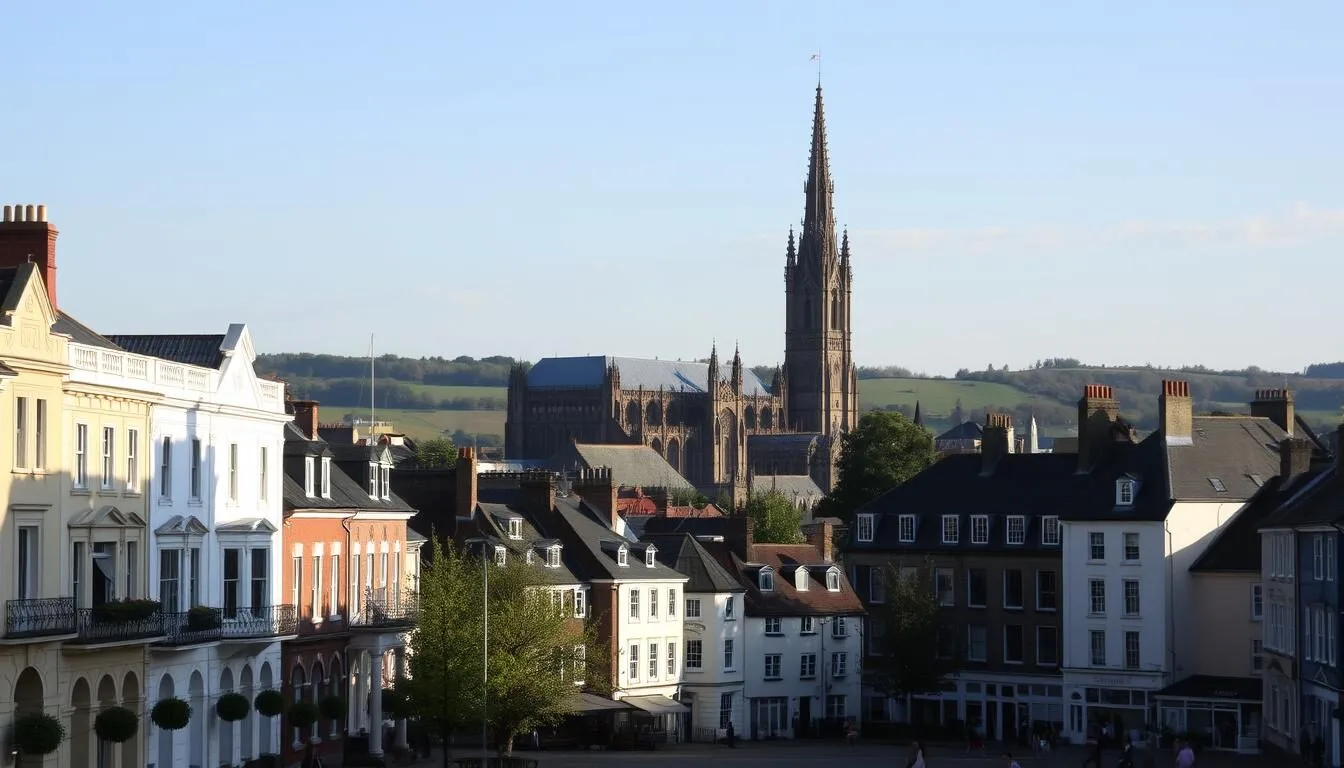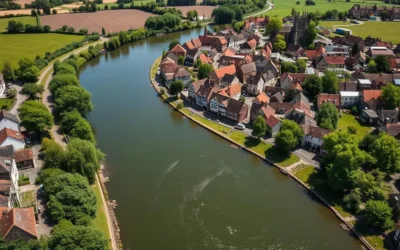Imagine strolling through a city where ancient history meets modern charm, and attractions are plentiful. You can explore the many things to do, from historic landmarks to vibrant cultural experiences, all within walking distance of each other.
As you visit this charming city, you’ll find that there’s plenty to see and do, from its rich history dating back to Roman times to its modern-day cultural hub. With distinct quarters to explore, you’ll uncover hidden gems and surprises along the way.
Discovering Exeter: A Historic City in the Heart of Devon
Located on the banks of the River Exe, Exeter is a captivating city that offers a mix of old and new attractions. As you explore Exeter, you’ll discover its rich history, cultural landmarks, and vibrant atmosphere.
Where is Exeter Located?
Exeter is strategically situated in the southwest of England, in the heart of Devon county. Its position on the River Exe has played a significant role in shaping the city’s history and development, particularly during the 17th and 18th centuries when it became a thriving trading hub due to the woollen cloth trade.
The city’s location makes it an ideal base for exploring the surrounding coast and countryside, with good transport links to nearby attractions. You can easily visit the picturesque villages of Devon, enjoy the beautiful beaches along the coast, or venture into the stunning Dartmoor National Park.
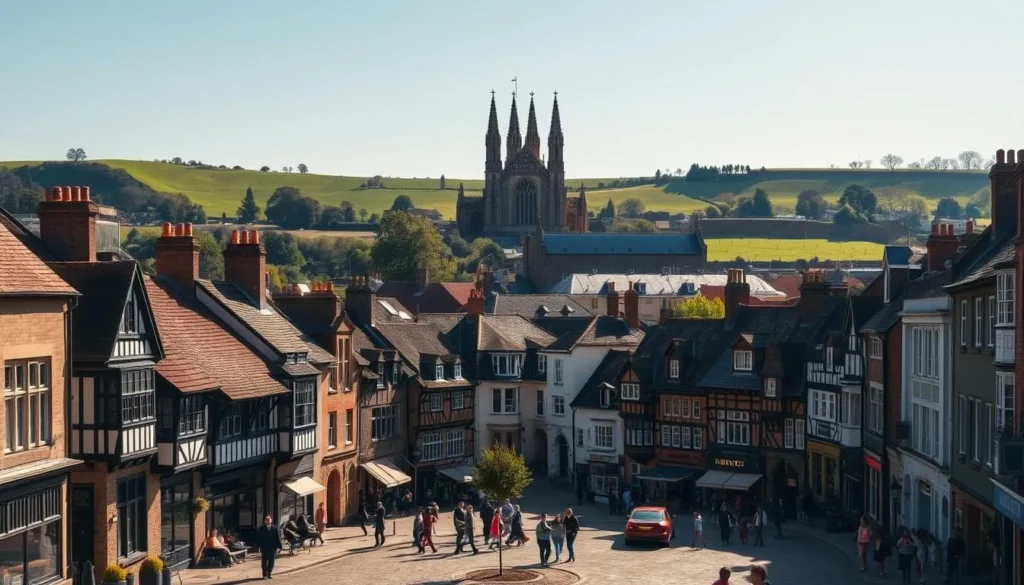
Brief History of Exeter
Exeter’s history dates back to Roman times when it was known as Isca Dumnoniorum. Over the centuries, the city has experienced significant events that have shaped its current appearance. From its Medieval prosperity to the impact of the Civil War and WWII bombings, Exeter’s history is a fascinating tale of resilience and growth.
The city’s rich heritage is still visible in its architecture, with many historic buildings and landmarks that tell the story of Exeter’s past. As you walk through the city, you’ll discover hidden gems and historic sites that showcase its unique character.
- Roman origins: Exeter was founded by the Romans in 50 AD.
- Medieval prosperity: The city flourished during the Medieval period.
- Civil War impact: Exeter played a significant role in the English Civil War.
How to Get Around Exeter
Exeter is a compact city, making it easy to explore on foot. Most attractions are within walking distance of each other, allowing you to discover the city’s hidden gems at your own pace. For those who prefer not to walk, there are excellent public transportation options, including buses and trains, that connect Exeter to nearby towns and cities.
The city is also bike-friendly, with designated cycling paths and routes that make it perfect for day trips to nearby attractions. You can rent a bike and enjoy the scenic views of the surrounding countryside or explore the city’s many parks and gardens.
Getting around Exeter is convenient, with a range of options to suit your preferences. Whether you choose to walk, cycle, or use public transport, you’ll find that Exeter is a city that’s easy to navigate and enjoy.
Exeter Cathedral: A Gothic Masterpiece

As you step into the heart of Exeter, you’re immediately struck by the majestic presence of Exeter Cathedral. This magnificent structure is not only a testament to the city’s rich history but also a prime example of Gothic architecture that you won’t want to miss during your visit.
Exeter Cathedral is renowned for being one of England’s most impressive Gothic buildings, making it a top attraction in the city. Its construction began in 1275 and was completed in 1342, rivaling the beauty of Salisbury Cathedral.
The Cathedral’s Fascinating History
The history of Exeter Cathedral is as captivating as its architecture. Originally built on the site of a Roman fort and later a Saxon church, the current structure reflects the city’s medieval past. Over the centuries, it has undergone various transformations, with the most significant being its completion in the 14th century.
Understanding the history behind Exeter Cathedral enhances your appreciation of this magnificent structure. You can explore this rich history further through the various tours available.
Architectural Highlights to Look For
One of the standout features of Exeter Cathedral is its stunning Gothic architecture, including the world’s longest uninterrupted Medieval Gothic vaulting. As you look around, you’ll notice the intricate carvings, the astronomical clock, and the minstrel’s gallery, each telling a story of the cathedral’s past.
When you visit Exeter Cathedral, take your time to admire these architectural marvels. The exterior is equally impressive, with carvings that took over 200 years to complete.
Visiting Information and Guided Tours
Planning your visit to Exeter Cathedral is straightforward. The cathedral is open daily, and while entry is free, donations are welcome. Adults are suggested to contribute £7.50, with discounts available for seniors and students. Residents and those under 18 enter for free.
To enhance your experience, consider joining one of the guided tours. These tours provide insights into the cathedral’s history and architectural details that you might otherwise miss.
After exploring the cathedral, take a stroll around the Cathedral Green, a popular spot, especially on sunny days. It’s the perfect place to relax and enjoy the surroundings.
Exploring Exeter’s Historic Quayside
As you wander through Exeter, you’ll discover the historic quayside, a picturesque area that seamlessly blends history with modern leisure activities. Located just a 15-minute walk from the city center, this fascinating area is steeped in history, boasts interesting architecture, and offers a variety of waterside pubs, restaurants, and cafes.
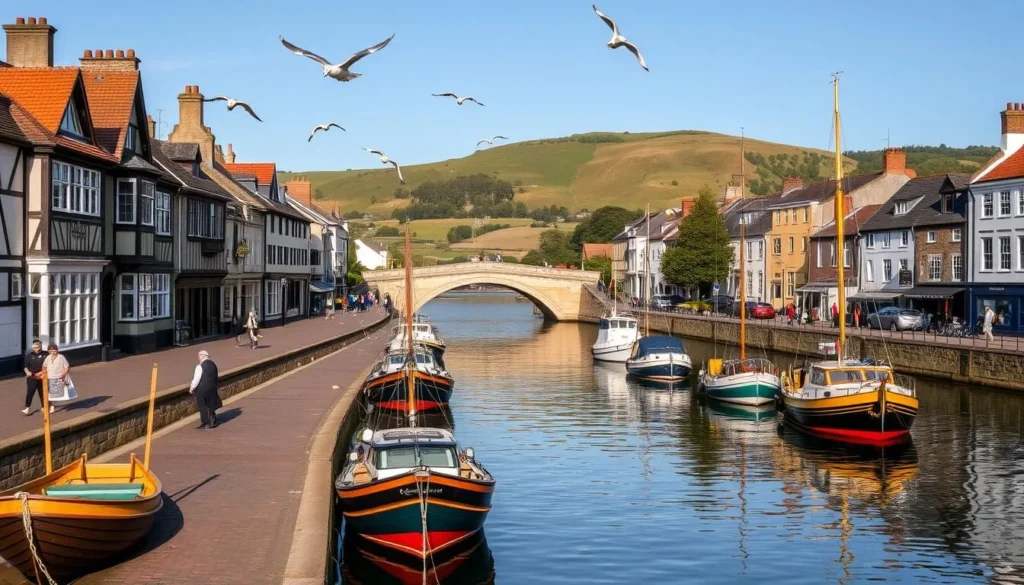
The Quayside’s Rich History
The Historic Quayside has a storied past, dating back to the 13th century when it was blocked by the Countess of Devon. It was later reopened under the influence of King Henry VIII, marking a significant turning point in its history. Today, visitors can still see remnants of this historical significance.
The area has evolved over the centuries, transforming into the vibrant quayside you see today. Its history is palpable, with many original features still intact, providing a unique glimpse into Exeter’s past.
The Customs House: A Historic Gem
One of the quayside’s most notable landmarks is the Customs House, built in 1680 during the height of the wool trade. This beautiful building is renowned for its sweeping staircase and ornate plaster ceilings. Today, it serves as a visitor center, bringing the history of the Quayside to life.
Visitors can explore the Customs House and learn about its significance in Exeter’s trading history. The building itself is a testament to the city’s rich heritage and a must-visit attraction.
Dining Along the Quay
The quayside is not just about history; it’s also a food lover’s paradise. You’ll find a variety of dining options, from seafood restaurants like Rockfish to casual eateries such as At the Waterfront. Whether you’re in the mood for a leisurely breakfast, a relaxing lunch, or a romantic dinner, there’s something for everyone.
The area’s dining establishments offer a range of cuisines, ensuring that visitors can enjoy a meal that suits their taste. The combination of good food and picturesque views makes for a memorable dining experience.
Activities on the Quayside
Beyond its historical significance and dining options, the quayside offers a range of activities. You can enjoy cycling, walking, or take a relaxing boat trip along the River Exe. For the more adventurous, watersports and climbing are also available.
The quayside transforms throughout the seasons, hosting various events and providing a relaxing atmosphere for both locals and visitors. Whether you’re looking for a morning coffee, an afternoon stroll, or an evening meal, the quayside is a great place to be.
Underground Adventures: Exeter’s Subterranean Passages
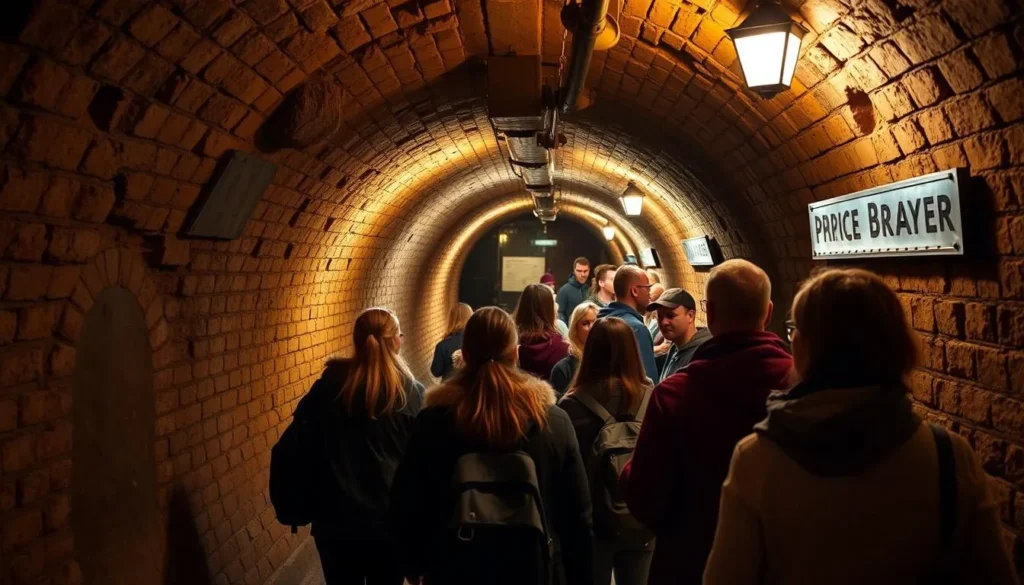
Beneath the streets of Exeter lies a hidden network of subterranean passages waiting to be explored. Exeter’s Underground Passages are a unique attraction that allows you to step back in time and experience the city’s medieval history firsthand.
The History and Purpose of the Passages
The Exeter Underground Passages were built in the 14th and 15th centuries to bring clean drinking water into the city from natural springs outside the city walls. This medieval engineering feat is now recognized as a unique ancient monument, showcasing the ingenuity of Exeter’s ancestors.
The passages played a crucial role in the city’s survival, providing a reliable source of clean water during times when the city faced numerous challenges, including the Black Death.
What to Expect on a Guided Tour
On a guided tour of the Exeter Underground Passages, you will navigate through narrow, winding tunnels while learning about the history and significance of this medieval water system. The tour guides provide fascinating commentary, bringing the history to life as you explore the subterranean network.
The experience is both educational and thrilling, offering a unique perspective on Exeter’s history.
Practical Information for Visitors
Tours of the Exeter Underground Passages must be booked in advance to ensure availability. The cost is £7.50 for adults, £5.00 for children, and £22.00 for a family of four. It’s essential to note that the passages may not be suitable for everyone, particularly those with claustrophobia or very young children who might find the experience intimidating.
An exhibition area complements the underground tour, providing additional context about Exeter’s history and the significance of the passages.
By visiting the Exeter Underground Passages, you are not only exploring a unique attraction but also uncovering a vital part of the city’s history. The passages offer a captivating glimpse into Exeter’s medieval past, making them a must-visit attraction for anyone interested in history, architecture, or the city‘s hidden gems.
The Royal Albert Memorial Museum & Art Gallery
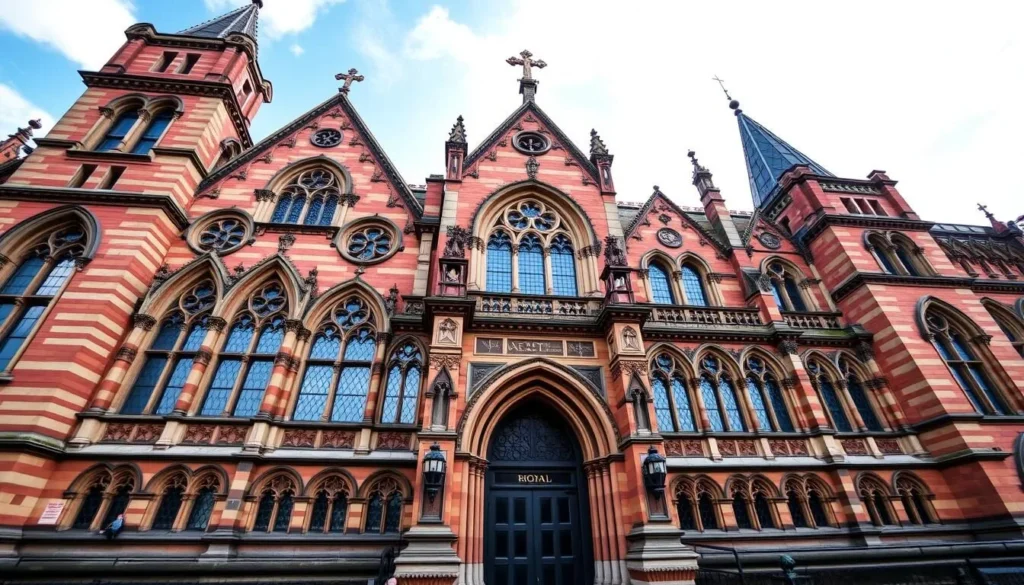
Step into the Royal Albert Memorial Museum & Art Gallery and discover the fascinating history of Exeter and beyond. As one of Exeter’s premier cultural attractions, this award-winning museum is housed in a stunning Victorian Gothic building that is a work of art in itself.
Collections and Exhibitions
The Royal Albert Memorial Museum & Art Gallery boasts diverse collections that span local history, archaeology, world cultures, natural history, and fine art. With prestigious loans and exhibitions from national partners, the museum offers something for everyone. You can explore exhibits that tell the story of Exeter and Devon’s rich history, or marvel at the natural world through the museum’s extensive natural history collections.
Some of the notable exhibits include artifacts that highlight Exeter’s significant role in history, as well as items from around the world that showcase the diversity of human culture. The museum’s exhibitions are both informative and engaging, making it an excellent destination for families and history buffs alike.
The Building’s Victorian Architecture
The museum’s building is an architectural landmark in Exeter, featuring stunning Victorian Gothic design. Recent restoration work has revealed newly-discovered architectural features, adding to the building’s splendor. As you explore the museum, take time to appreciate the intricate details and craftsmanship that make this building a masterpiece of Victorian architecture.
Visitor Information
Visiting the Royal Albert Memorial Museum & Art Gallery is a great way to spend the day, and with free entry, it’s an activity that’s accessible to everyone. The museum is open from Tuesday to Sunday, 10 am – 5 pm. You can easily spend a few hours exploring the exhibitions and enjoying the facilities. The museum is also family-friendly, with interactive displays and activities designed to engage children and inspire their curiosity.
To plan your visit, be sure to check the museum’s website for any special events or temporary exhibitions that may interest you. With its rich collections, stunning architecture, and welcoming atmosphere, the Royal Albert Memorial Museum & Art Gallery is a must-visit destination in Exeter.
Exeter’s City Walls and Medieval Heritage
Exeter’s city walls, a testament to the city’s history, stand as one of the finest examples of Roman defensive architecture in Britain. Originally stretching over a mile around the ancient city, these walls have been adapted and modified by various historical groups throughout the centuries, making them a fascinating subject for exploration.
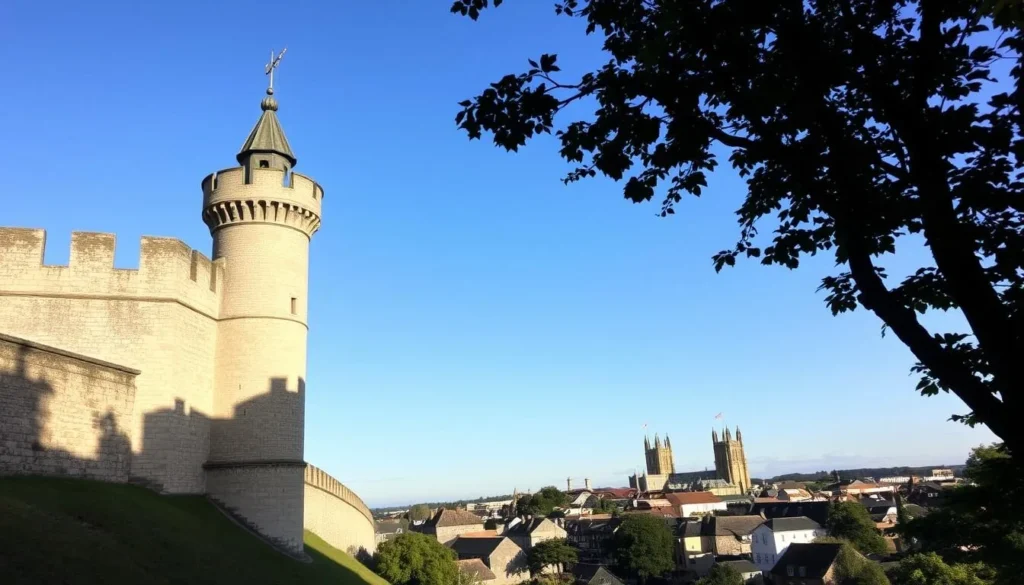
The Origins of the Walls
The Romans first built Exeter’s city walls around 200 AD, forming the foundation of the city’s defensive system. These walls were not just a military necessity but also a symbol of the city’s strength and status. As you walk along the remaining sections of the walls, you can still see the different types of brickwork and stone markings that indicate when various parts were built or repaired over time.
Exploring the City Wall Trail
One of the best ways to appreciate Exeter’s medieval heritage is by following the City Wall Trail. This walk takes you through some of the city’s most historic areas, offering insights into Exeter’s development from Roman times through the Medieval period. As you walk, notice the unique features of the walls and the surrounding buildings, which together tell the story of Exeter’s rich past.
Discovering Hidden Medieval Gems
Along the City Wall Trail, you’ll discover hidden medieval gems that reveal Exeter’s rich history. The walls provide excellent vantage points for viewing both historic and modern buildings in the city, giving you a unique perspective on Exeter’s evolution over time. As you explore, keep an eye out for lesser-known historic buildings and structures that are tucked away along the route, adding to the city’s charm and character.
By exploring Exeter’s city walls and following the City Wall Trail, you’ll gain a deeper understanding of the city’s history and its significance in British heritage. Whether you’re a history buff or simply looking for a unique way to experience Exeter, the city walls offer a compelling and enriching experience.
Unique Historical Curiosities in Exeter
As you explore Exeter, you’ll uncover a treasure trove of unique historical curiosities that offer a glimpse into the city’s rich past. Exeter is a city with a deep history, and its hidden gems are waiting to be discovered.

The House That Moved: An Engineering Marvel
One of Exeter’s most fascinating historical curiosities is “The House That Moved,” a medieval building that was physically relocated in the 1960s to save it from demolition. This remarkable feat of engineering was achieved using a system of iron rails and wheels, allowing the house to be transported to its current location on West Street. The house, which dates back to a time when land space was a significant issue, features a larger first and second floor than ground floor, a characteristic common in medieval buildings.
Originally situated at the corner of Edmund Street and Frog Street, the house was slated for destruction due to a new road construction project. However, thanks to protests from archaeologists and citizens, a solution was found to preserve this piece of Exeter’s history. Today, the house stands, albeit a little crooked, and its ground floor is now home to a bridal shop.
Parliament Street: The Narrowest Street in Britain
Another intriguing historical curiosity in Exeter is Parliament Street, claimed to be the narrowest street in Britain, measuring just 25 inches at its narrowest point. This tiny street raises questions about what qualifies as a street versus an alleyway. Despite its diminutive size, Parliament Street is a significant part of Exeter’s history and a point of interest for visitors.
The Exeter Touchstone and Other Superstitions
Near Exeter Cathedral lies the Exeter Touchstone, a stone steeped in superstition. Medieval travelers would touch this stone upon entering the city to rid themselves of evil spirits encountered during their journey. Interestingly, there’s a belief that touching the stone when leaving would cause one to take all the stored evil spirits with them, a notion that likely deterred many from doing so. This and other superstitions are a part of Exeter’s rich cultural heritage, offering insights into the beliefs and practices of the time.
Exeter is also home to other curious historical features, such as the medieval Exe Bridge ruins and St. Catherine’s Almshouses. Visitors can embark on a self-guided walking route that connects these unique historical curiosities, allowing them to discover a different side of Exeter’s history and appreciate its buildings.
- Explore “The House That Moved,” a medieval building relocated in the 1960s.
- Visit Parliament Street, claimed to be Britain’s narrowest street.
- Discover the Exeter Touchstone and its associated superstitions.
- Walk along Exeter’s city walls and explore its medieval heritage.
Shopping in Exeter: From High Street to Independent Boutiques
From well-known high street names to charming independent boutiques, Exeter’s shopping district has something for everyone. Exeter’s compact size makes it great for shopping, with big High Street names and a wealth of independents all within easy walking distance of each other, interspersed with lots of choice of places to eat and drink.
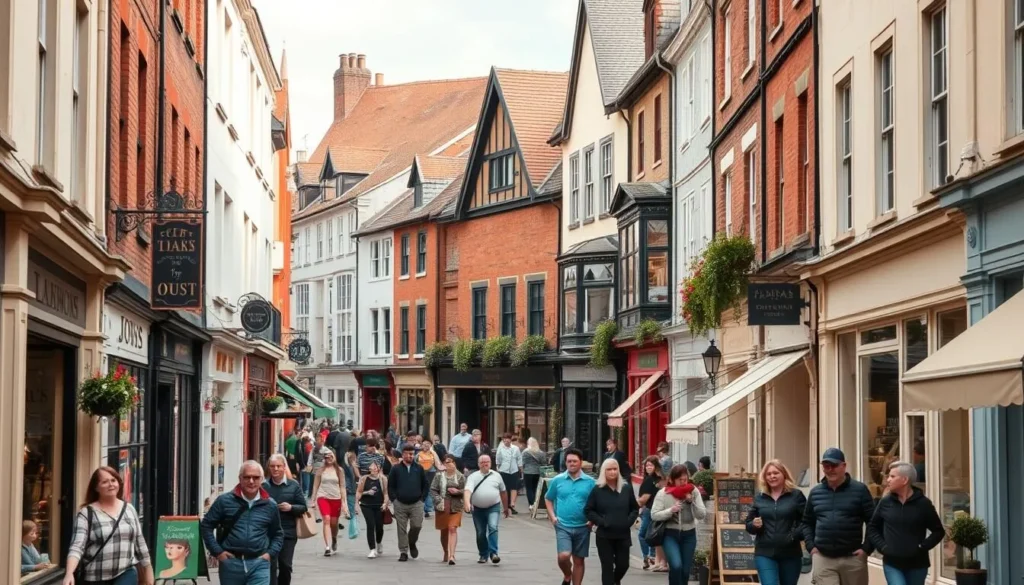
Gandy Street: The Real-Life Diagon Alley
Gandy Street is a charming, narrow lane filled with independent shops and cafes. It’s rumored to have inspired Diagon Alley in the Harry Potter series, as J.K. Rowling studied at Exeter University. You’ll find unique gifts and souvenirs here, making it a must-visit area for anyone looking for things that are a little different.
Fore Street and the Independent Quarter
Fore Street is part of the Independent Quarter of Exeter, where you’ll discover artisan crafts, vintage stores, and local designers. This area of the city is special because it showcases the creativity and individuality of Exeter’s local community. Whether you’re looking for handmade jewelry or bespoke clothing, Fore Street is the place to find unique and original items.
Princesshay and High Street Shopping
For a more mainstream shopping experience, Princesshay and the High Street offer well-known brands in a modern setting. While maintaining architectural connections to Exeter’s history, these areas provide a contemporary shopping environment. You’ll find a range of shops here, from fashion to homeware, making it a great place to visit for anyone looking for a traditional shopping experience.
Exeter’s shopping experience is further enhanced by its various retail quarters, including the boutique shops of the Cathedral Quarter and the hidden gems of the Castle Quarter. Visitors can enjoy a shopping itinerary that takes them through the different quarters, experiencing the full range of what Exeter has to offer. Seasonal shopping events and markets, such as Christmas markets and summer craft fairs, add to the retail experience, making Exeter a vibrant and exciting place to shop.
Outdoor Activities in Exeter
From tranquil canal rides to cycling through picturesque estuaries, Exeter is a haven for outdoor enthusiasts. The city’s unique location, surrounded by rolling countryside and bisected by the River Exe, offers a diverse range of outdoor pursuits that cater to all interests and abilities.
Water Activities on Exeter Canal
One of the joys of visiting Exeter is exploring its waterways. Canoeing and paddleboarding are popular activities on the Exeter Canal, offering a serene way to enjoy the city’s scenery. You can rent equipment from Saddles & Paddles, a company that provides high-quality canoes and paddleboards.
A favorite journey for both locals and visitors is the scenic paddle route to the Double Locks Pub. This route offers a unique perspective of the city, gliding past historic buildings and enjoying the tranquil atmosphere of the canal.

Cycling the Exe Estuary Trail
For those who prefer cycling, the Exe Estuary Trail is a must-visit. This 26-mile route connects charming villages and offers spectacular views of the estuary. The trail is suitable for cyclists of all abilities, making it a perfect activity for families or casual riders.
You can rent bikes from Saddles & Paddles, which also offers advice on the best routes and itineraries for your cycling adventure.

Exploring Exeter’s Walking Trails
Exeter is also surrounded by numerous walking trails that showcase the region’s natural beauty. From urban routes that connect historic sites to nature paths that highlight the local flora and fauna, there’s a trail to suit every interest.
Seasonal outdoor activities abound in Exeter, with spring wildflower walks, summer watersports, autumn cycling when the estuary is ablaze with color, and winter bird-watching along the Exe being particularly popular.
In conclusion, Exeter’s outdoor activities offer something for everyone, whether you’re interested in water sports, cycling, or simply taking a leisurely walk. The city’s natural beauty and diverse landscapes make it an ideal destination for outdoor enthusiasts.
Free Things to Do in Exeter
Exeter is a treasure trove of free things to do, from guided tours to beautiful gardens. You can experience the city’s rich history and culture without spending a fortune. Here are some of the top free activities to enjoy in Exeter.
Red Coat Guided Tours
One of the best ways to explore Exeter is on a Red Coat Guided Tour. These daily tours are led by knowledgeable guides dressed in traditional red coats, offering insights into the city’s history and landmarks. You can choose from various themed tours, including Historic Exeter, Georgian Exeter, Medieval Exeter, Forgotten Exeter, and Exeter Old & New. The tours depart from either Exeter Cathedral or the quayside at 11 am, making it easy to fit into your day.
- Historic Exeter tour: Explore the city’s historic landmarks and learn about their significance.
- Georgian Exeter tour: Discover the city’s Georgian heritage and architecture.
- Medieval Exeter tour: Uncover the city’s medieval past and its hidden gems.
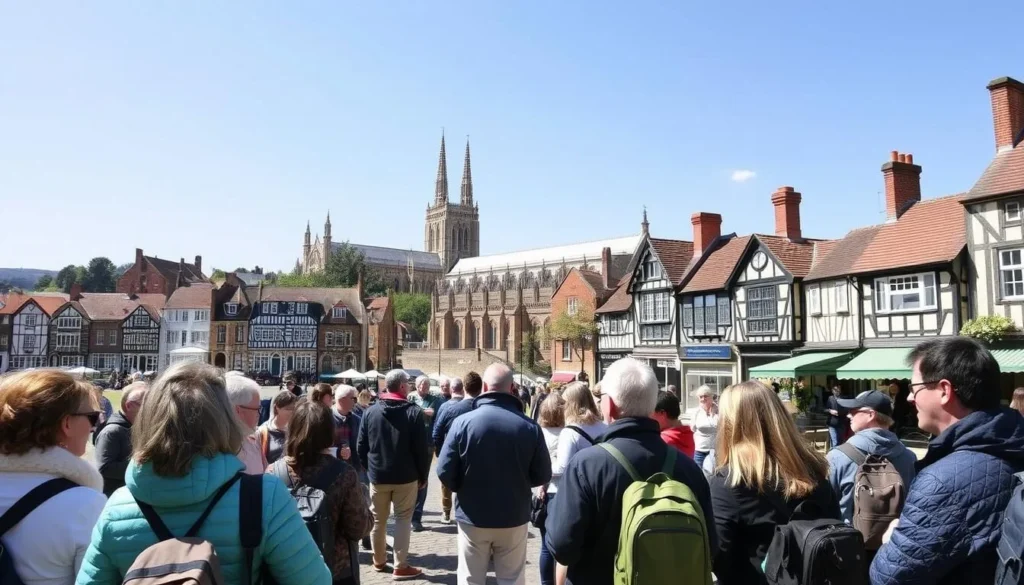
Exploring Exeter’s Parks and Gardens
Exeter is home to many beautiful parks and gardens that are perfect for a relaxing stroll. Northernhay Gardens, the oldest public open space in England, is a must-visit, with its stunning floral displays and tranquil atmosphere. You can also explore Rougemont Gardens and the University of Exeter’s stunning campus grounds, which offer a peaceful escape from the city bustle.
Depending on the season, you can enjoy spring flowers, summer events, and autumn foliage in these green spaces. Take a leisurely walk and soak up the natural beauty of Exeter’s parks and gardens.
Self-Guided Walking Routes
If you prefer to explore Exeter at your own pace, consider one of the many self-guided walking routes available. The City Wall Trail takes you along the city’s historic walls, offering a glimpse into Exeter’s medieval past. Alternatively, the Exeter Green Circle is a scenic route that explores the city’s green spaces and hidden gems.
You can also visit certain attractions like the Royal Albert Memorial Museum and the Custom House Visitor Centre, which offer free access and provide a wealth of cultural experiences.
Day Trips from Exeter
You can explore the best of Devon with Exeter as your starting point, thanks to its convenient location. Exeter is surrounded by historic towns, stunning national parks, and beautiful beaches, all within easy reach for a day trip.
Historic Topsham
Just a few miles from Exeter lies the charming riverside town of Topsham. You can easily get to Topsham by bike, bus, or train. This historic port is known for its maritime heritage and Dutch-style architecture. Take a stroll along the famous Goat Walk, which offers breathtaking views of the estuary.
Discovering Dartmoor National Park
Dartmoor National Park is a short drive from Exeter, offering dramatic landscapes, ancient stone circles, and picturesque villages to explore. You can spend your day hiking, spotting wildlife, or visiting historic sites. Popular destinations within Dartmoor include Haytor, Widecombe-in-the-Moor, and Lydford Gorge.

A Beach Day at Exmouth
For a relaxing day trip, head to Exmouth, a beautiful coastal town that serves as the gateway to the Jurassic Coast World Heritage Site. You can enjoy Exmouth’s long sandy beaches and take part in various water sports. It’s an ideal spot to unwind and enjoy the natural beauty of Devon.
In addition to Topsham, Dartmoor, and Exmouth, there are many other great day trip destinations from Exeter. You might consider visiting the historic town of Totnes, the picturesque coastal villages of Beer and Branscombe, or the elegant regency resort of Sidmouth. Each of these places offers a unique experience, from historic landmarks to stunning natural beauty.
To plan your day trip, you can use public transportation or drive. Regular train and bus services connect Exeter to many surrounding towns and villages. If you prefer to drive, there are ample parking facilities at most destinations.
Powderham Castle: A Historic Estate
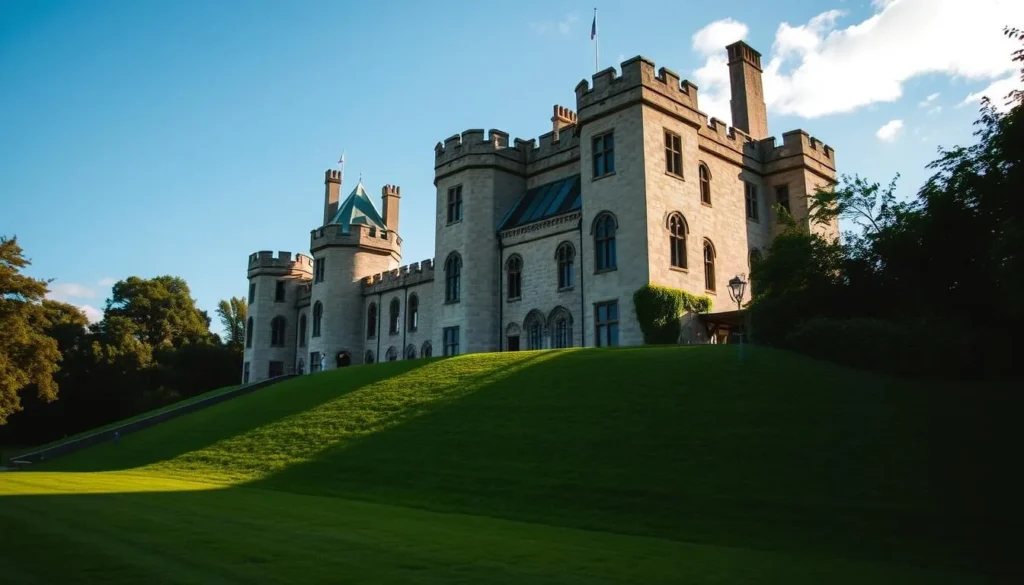
Located just a 20-minute drive from Exeter, Powderham Castle is a historic estate that has been home to the Courtenay family for 600 years. Still occupied by the same family, the castle’s history spans centuries, making it a fascinating destination for anyone interested in history and architecture.
The Castle’s 600-Year History
The castle has played a significant role in Devon’s history, particularly during the English Civil War. Over the centuries, it has evolved from a defensive structure to a family home, reflecting changing styles and needs. You can explore this rich history on a guided tour, discovering the castle’s medieval core and later additions.
Gardens and Grounds
The beautifully landscaped gardens and extensive grounds are perfect for a family outing. You can enjoy a picnic in the deer park, explore the rose gardens, or take a leisurely walk through the woodland walks. The grounds offer a serene and picturesque setting, ideal for spending time with family.
Events and Visitor Information
Powderham Castle hosts various events throughout the year, including historical reenactments, concerts, and seasonal celebrations. To plan your visit, check the castle’s opening times and guided tour options. The castle also features a café and gift shop, making it a convenient day trip from Exeter. You can combine your visit with other nearby attractions for a full day of exploration.
When you visit Powderham Castle, you can expect a memorable experience filled with history, beautiful gardens, and exciting events. Whether you’re interested in history, architecture, or simply spending time with family, Powderham Castle is an excellent choice for a day trip from Exeter.
Indoor Activities for Rainy Days
Exeter offers a range of thrilling indoor activities to enjoy on a rainy day. Whether you’re looking for adventure, relaxation, or a fun day out with the family, Exeter has something for everyone.
The Quay Climbing Centre
The Quay Climbing Centre is the largest climbing centre in Southwest England, offering a variety of climbing experiences for all skill levels. You can try bouldering, rope climbing, or the family-friendly Clip ‘n Climb section, perfect for kids aged 4 and up.

St Sidwell’s Point Spa
For a relaxing day out, visit St Sidwell’s Point Spa, the UK’s first Passivhaus spa. This innovative, environmentally-friendly wellness destination uses cutting-edge technology to maintain energy efficiency. Enjoy the steam room, sauna, sanarium, and hot tub for £20 per person for a two-hour session. You can also opt for additional access to the gym and pool.

Exeter Distillery Tours
If you’re interested in learning about spirit production, take a tour of the Exeter Quayside Distillery. Discover the distilling process and sample unique gin and vodka creations. It’s a fascinating insight into small-batch spirit production.

Exeter also offers other rainy day options, such as escape rooms, the Bill Douglas Cinema Museum, and indoor workshops at local craft centers. These activities provide fun and educational experiences for various interests and age groups, making Exeter a great destination for a family day out or a fun day with friends.
Where to Eat in Exeter
With its focus on locally-sourced ingredients, Exeter has become a top destination for food enthusiasts in the UK. The city offers a diverse culinary scene, ranging from fine dining establishments to casual eateries and charming cafes, ensuring there’s something for every taste and budget.
Fine Dining Options
For a sophisticated dining experience, Exeter has several fine dining options. Margoux, located in the heart of the city, stands out for its British and European cuisine paired with an extensive wine selection. This restaurant is a must-visit for anyone looking to indulge in high-quality food in an elegant setting.
Casual Eateries and Pubs
Exeter is also home to lots of casual dining spots that are perfect for a relaxed meal. The Terrace, Exeter’s premier rooftop bar, offers panoramic views of the city, making it a great place to enjoy a meal while taking in the sights. Another popular spot is Rockfish on the quayside, known for serving fresh seafood delivered daily from Brixham Harbor. For a taste of history, The Turk’s Head, one of Devon’s oldest pubs, now serves artisanal pizzas in a building dating back centuries.
Cafes and Coffee Shops
No visit to Exeter would be complete without exploring its many cafes and coffee shops. Places like Eat on the Green, facing Exeter Cathedral, offer a delightful atmosphere to enjoy a cup of coffee or a light meal. These spots are perfect for taking a break and soaking in the city’s atmosphere.
To help you navigate the many food options throughout different areas of the city, consider creating a food-focused itinerary. Whether you’re a seafood lover, vegetarian, history buff, or contemporary cuisine enthusiast, Exeter has lots of places to explore. The city’s focus on food and drink makes it an exciting destination for visitors.
| Restaurant/Cafe | Type | Location |
|---|---|---|
| Margoux | Fine Dining | Heart of the city |
| The Terrace | Rooftop Bar | City center |
| Rockfish | Seafood | Quayside |
| The Turk’s Head | Historic Pub | Old town |
| Eat on the Green | Cafe | Facing Exeter Cathedral |

Where to Stay in Exeter
Whether you’re looking for a historic boutique hotel or a modern family-friendly accommodation, Exeter’s got you covered. The city offers a diverse range of accommodations to suit every traveler’s needs, from luxurious hotels to budget-friendly guesthouses.
Luxury and Boutique Hotels
For a touch of luxury, consider the Headweir Mill House Hotel, a converted historic building offering individually styled rooms with character and charm. Staying in one of Exeter’s historic buildings that have been transformed into unique accommodations not only provides comfort but also a connection to the city’s past.
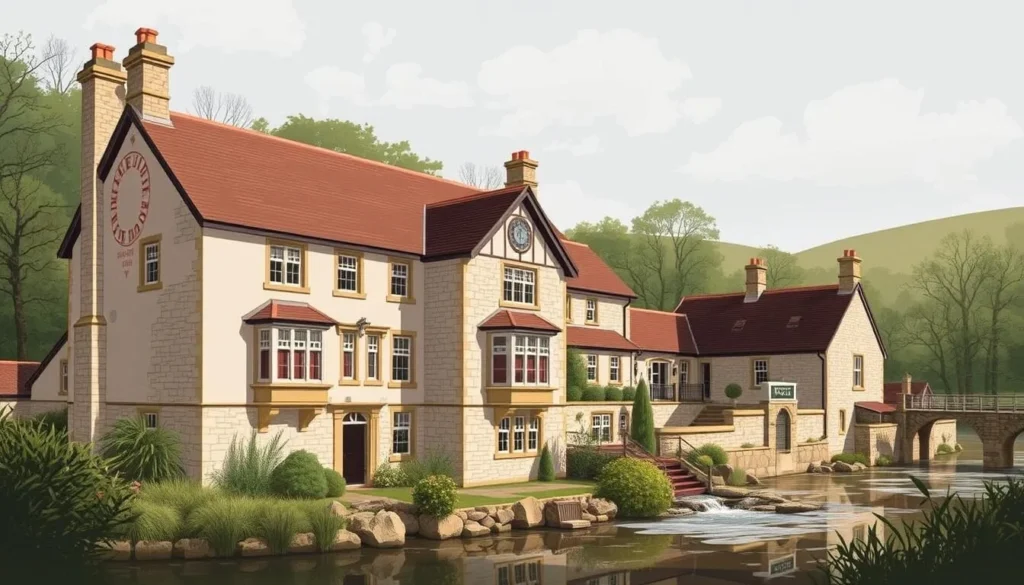
Mid-Range Accommodations
If you’re looking for good value, comfortable rooms, and convenient access to major attractions, Jury’s Inn is an excellent mid-range option located in the heart of the city. This modern hotel ensures a pleasant stay with its contemporary amenities.
Budget-Friendly Options
For travelers on a budget, The White Hart pub is a friendly establishment with cozy rooms right in the heart of the city, perfect for maximizing your trip experience while minimizing costs. It offers adequate space for a comfortable stay.
When choosing where to stay in Exeter, consider your preferences: whether you prefer being in the historic center, near the quayside, or in quieter residential neighborhoods with easy access to transportation. Exeter’s diverse accommodation options ensure that you find the perfect fit for your trip.
Planning Your Perfect Trip to Exeter
Whether you’re coming for a day, a weekend, or longer, Exeter has a multitude of experiences waiting for you. To make the most of your trip, it’s essential to plan ahead, considering the time of year and how it might impact your visit.
For those with limited time, a day trip to Exeter can be a great way to experience the city’s highlights. Prioritize the historic Quayside, Exeter Cathedral, and a stroll along the city walls. If you have a day or two more, you can explore the Underground Passages, visit the Royal Albert Memorial Museum, and enjoy the city’s shopping and dining scene.
The best time to visit Exeter depends on your preferences. Summer brings festivals and warm weather, ideal for outdoor activities like canoeing on the Exeter Canal. Spring is perfect for enjoying the city’s gardens, while autumn offers beautiful colors in the surrounding countryside. Winter visitors can enjoy festive markets and cozying up in one of Exeter’s many cafes or pubs.
Getting to Exeter is straightforward, with good road and rail links. If you’re driving, there are several car parks around the city, including the Cathedral Yard and Princesshay car parks. For those preferring public transport, regular train services connect Exeter to major UK cities, and local buses cover the city and its surroundings. To get around, you can walk, cycle, or use the bus services, making it easy to explore the city in a way that suits you.
To save money during your trip, consider purchasing combination tickets for attractions, take advantage of the city’s free attractions like the city walls and parks, and dine at some of the more affordable yet excellent eateries. Experiencing Exeter like a local involves exploring lesser-known spots, such as the tranquil St. Nicholas Priory and enjoying a coffee at one of the independent cafes on Fore Street.
When packing for your visit, be prepared for the changeable Southwest England weather. Bring layers, waterproof clothing, and comfortable shoes for walking. Don’t forget your camera to capture the things that make Exeter special, from its historic architecture to its vibrant cultural scene.
By planning your trip to Exeter thoughtfully, you can ensure a memorable and enjoyable visit, regardless of the length of your stay. With its rich history, cultural attractions, and friendly locals, Exeter is a city that has something for everyone.
